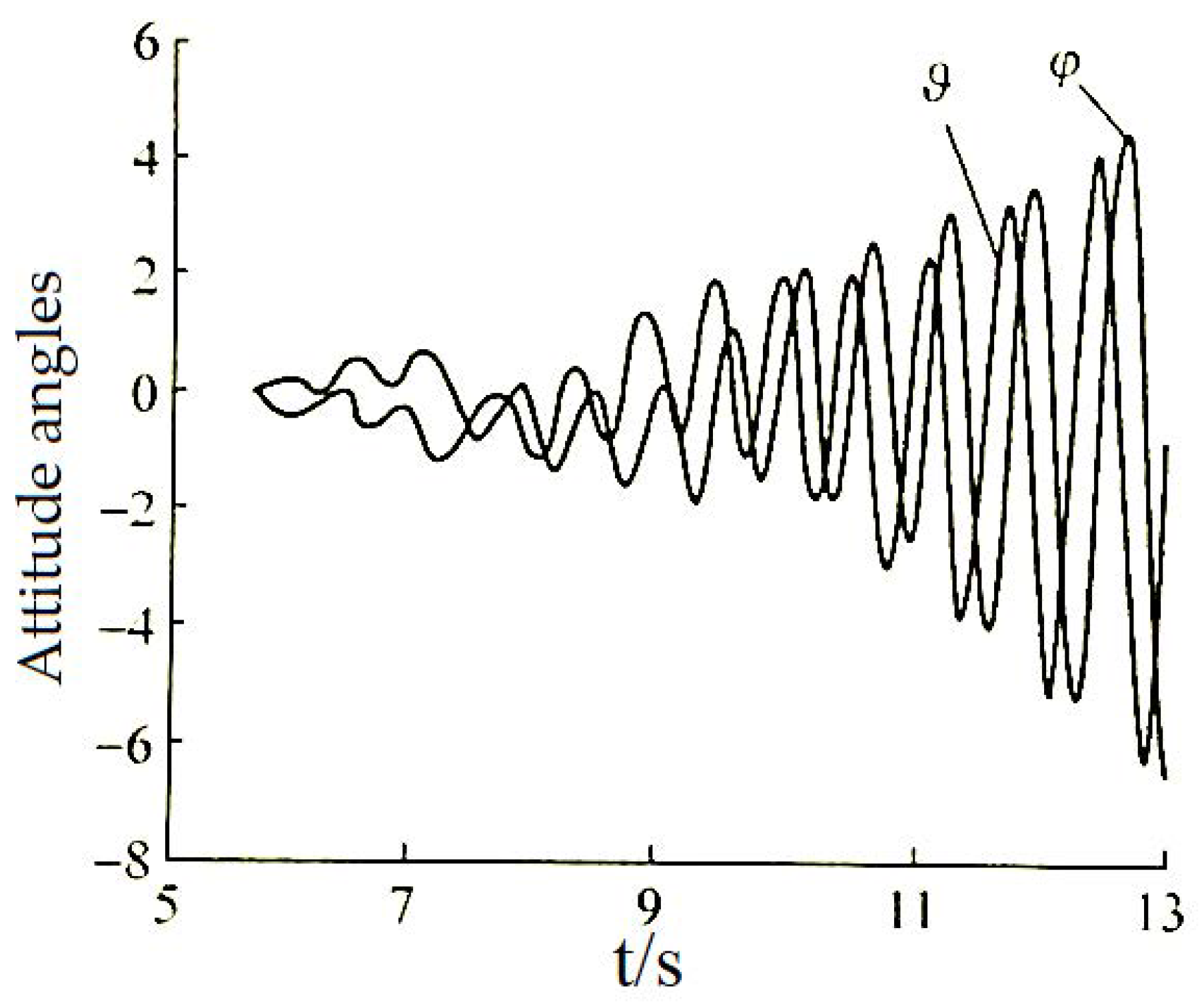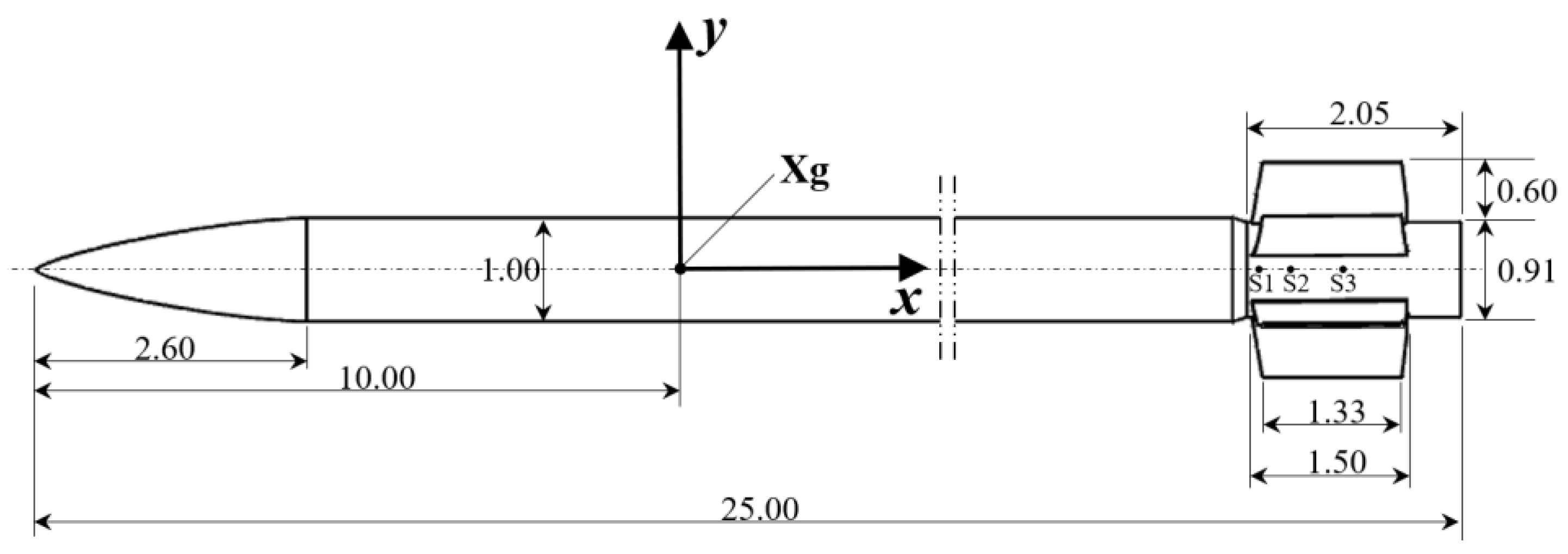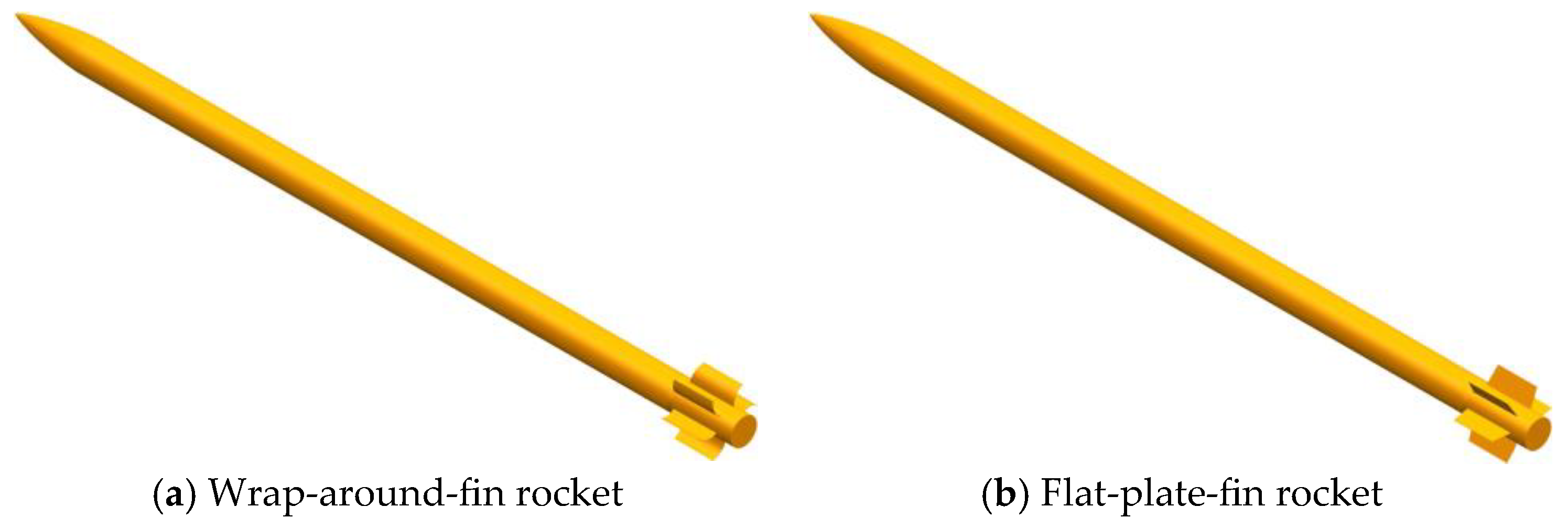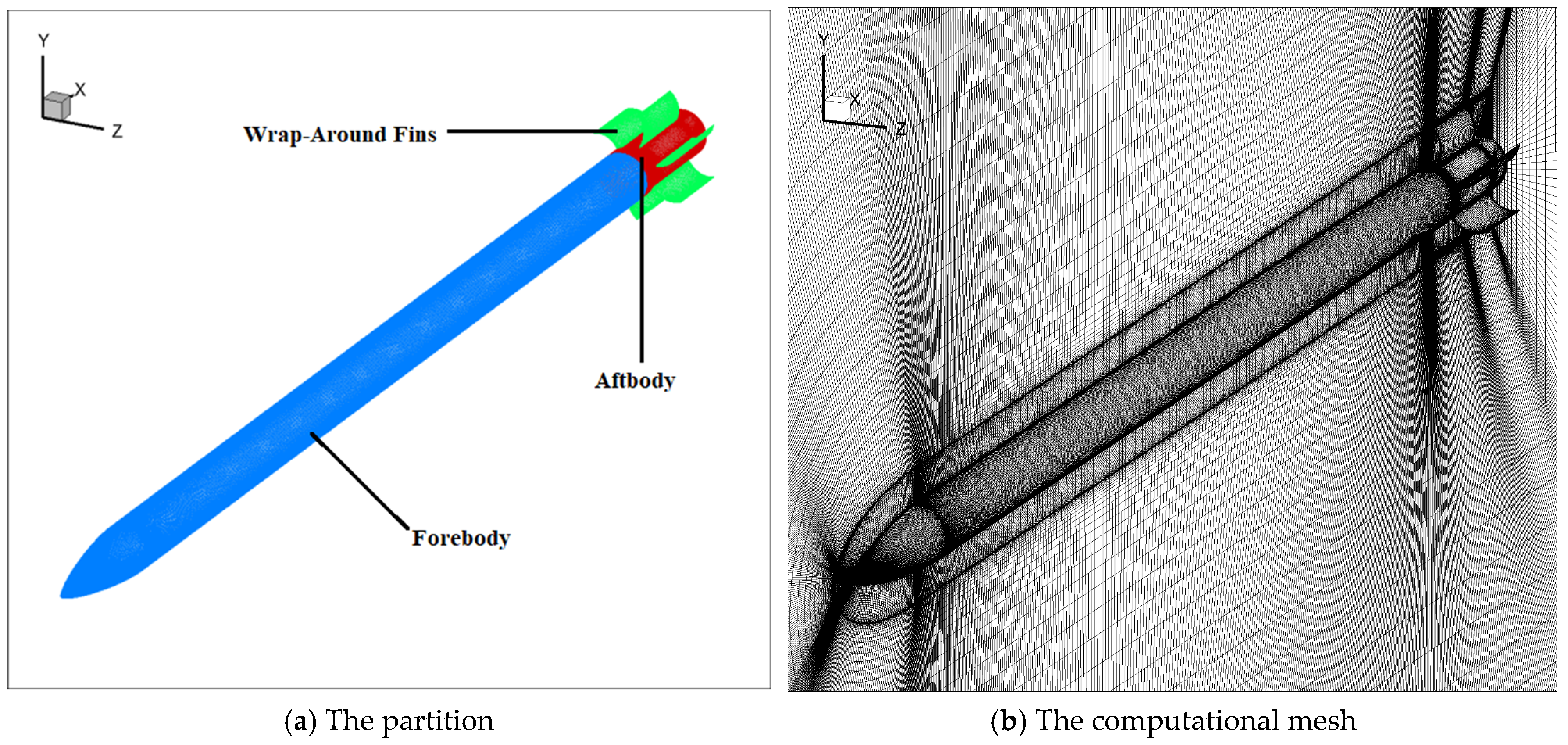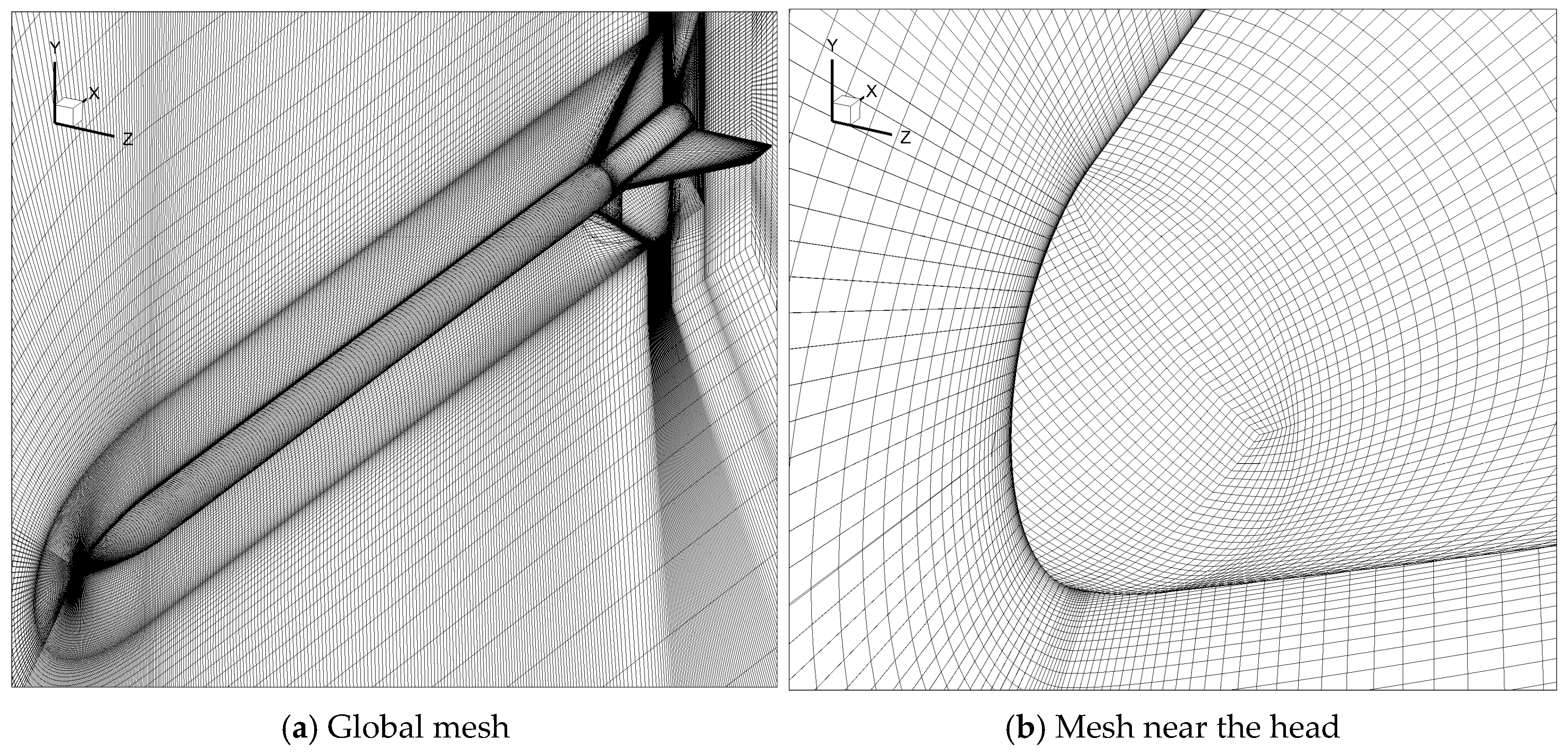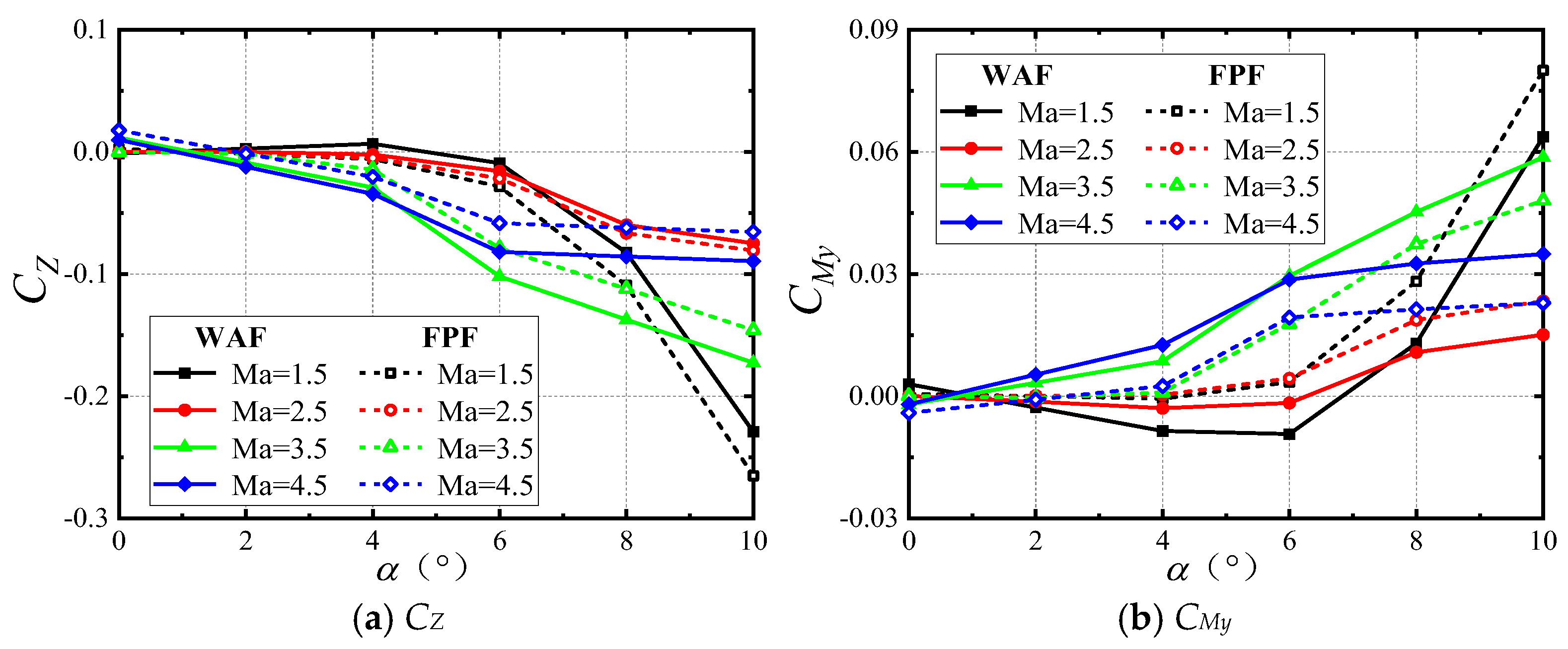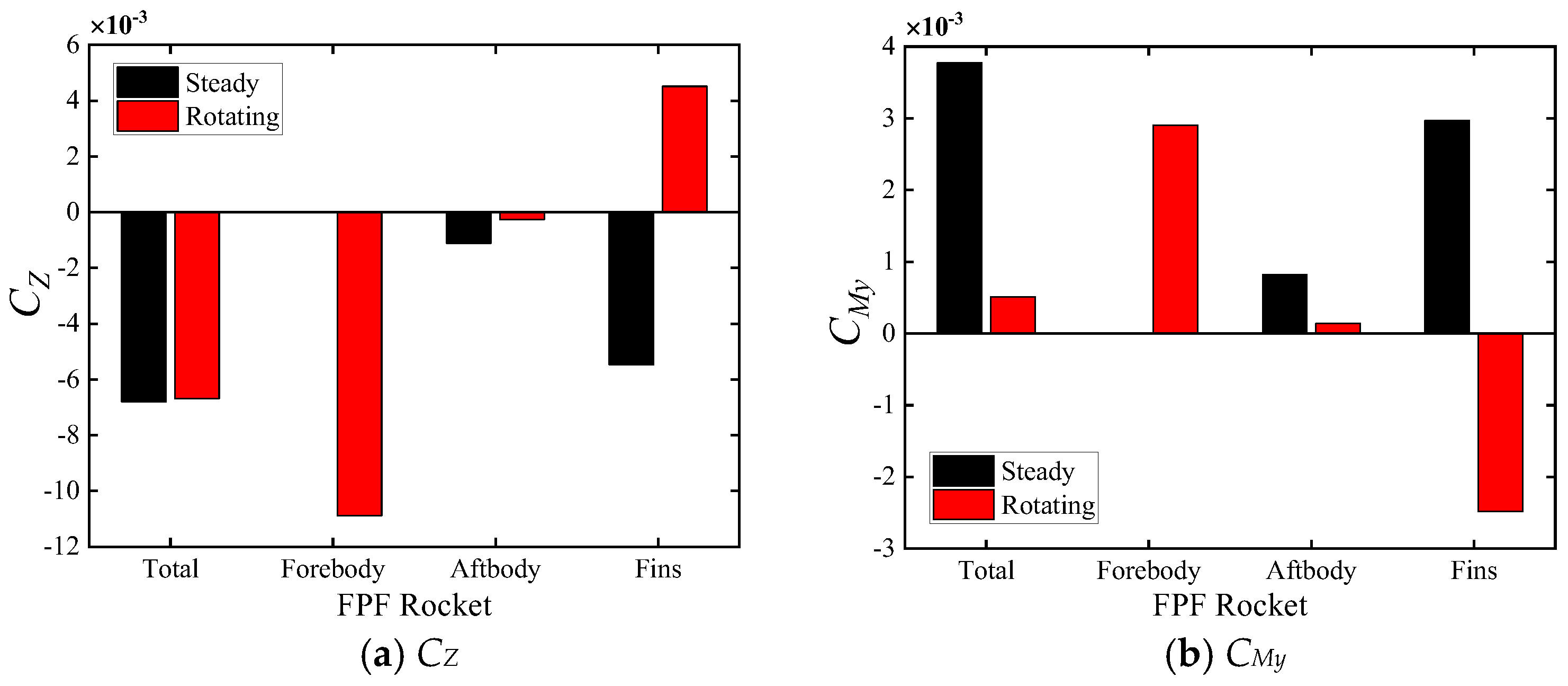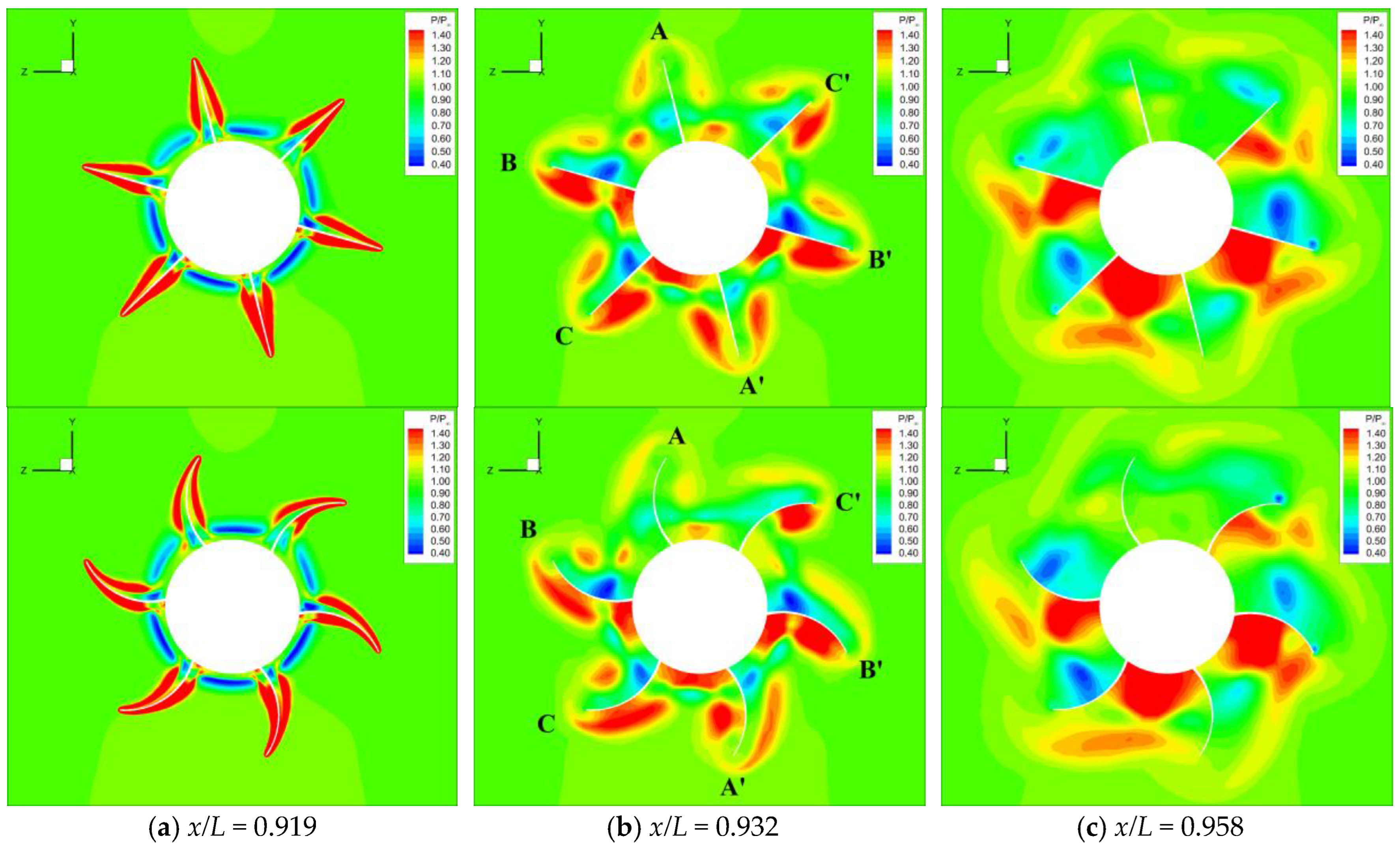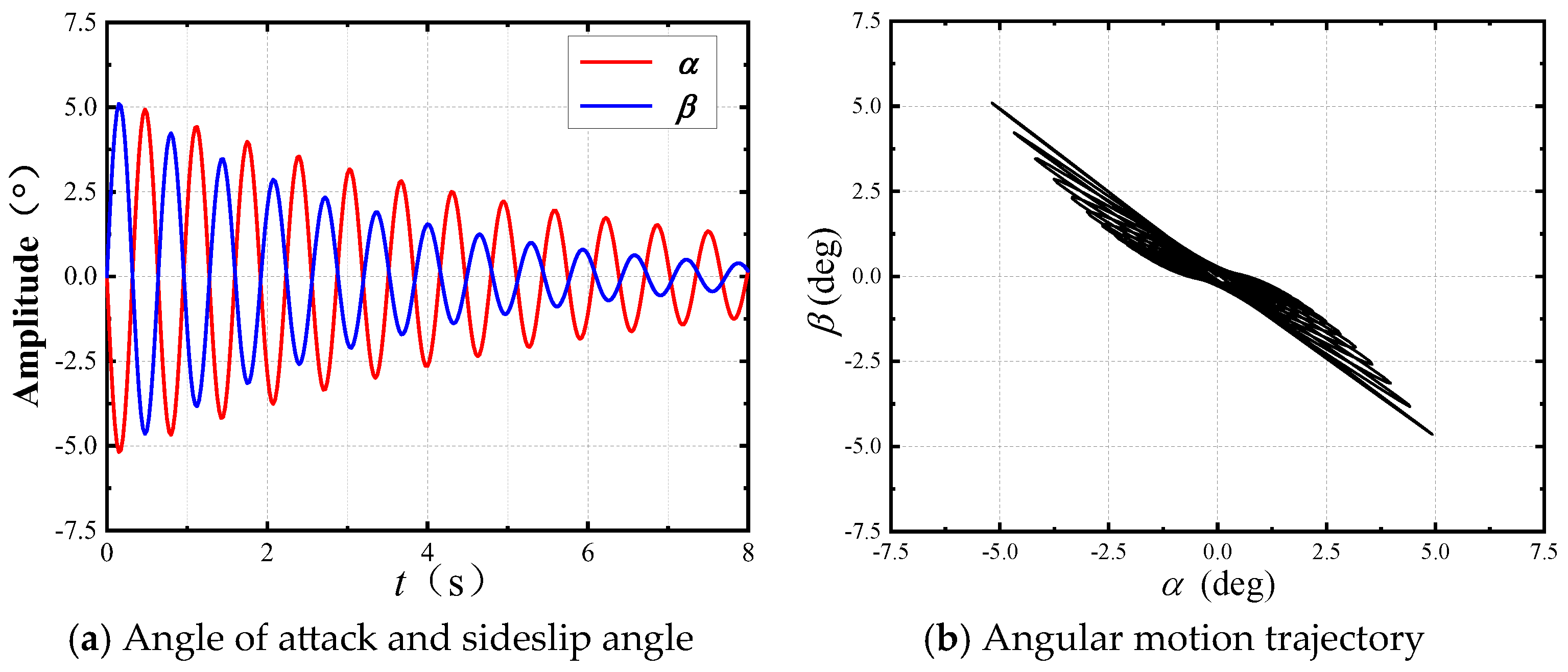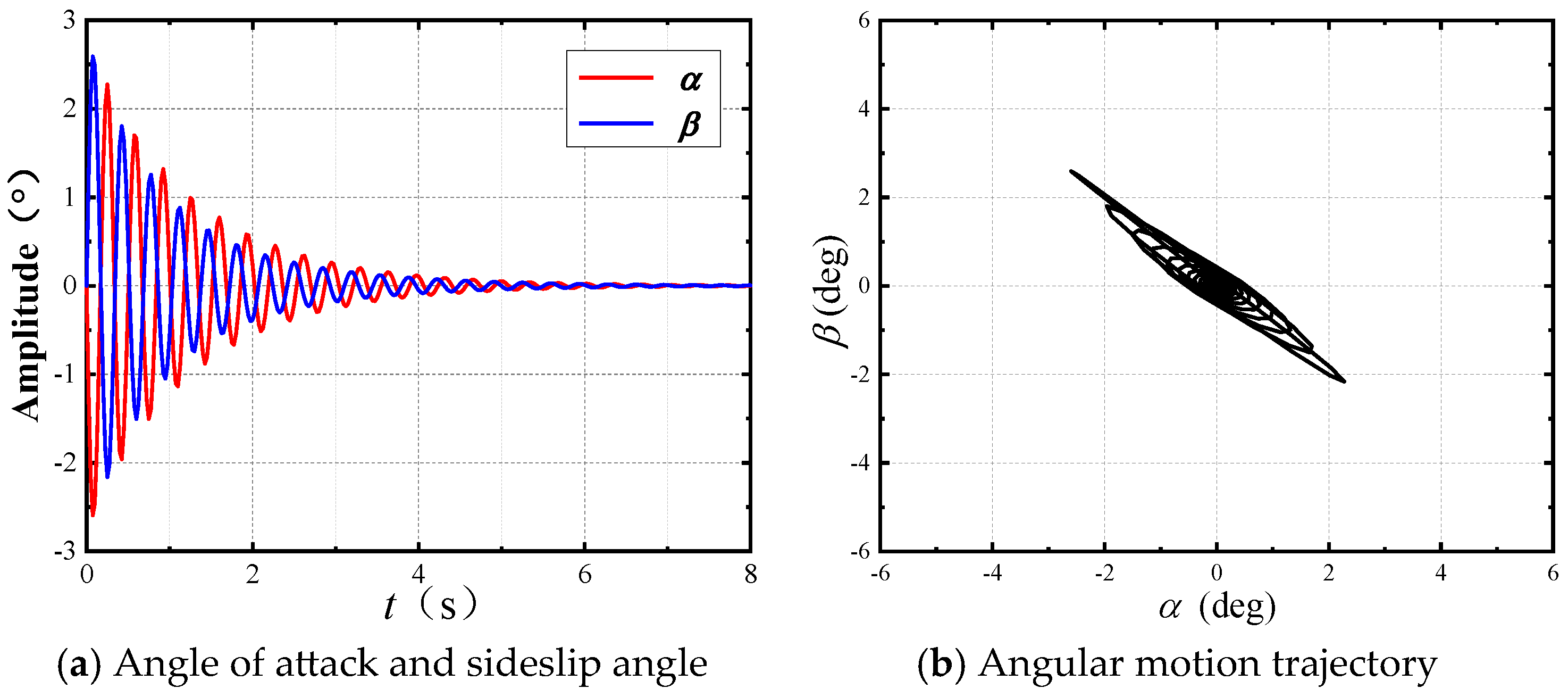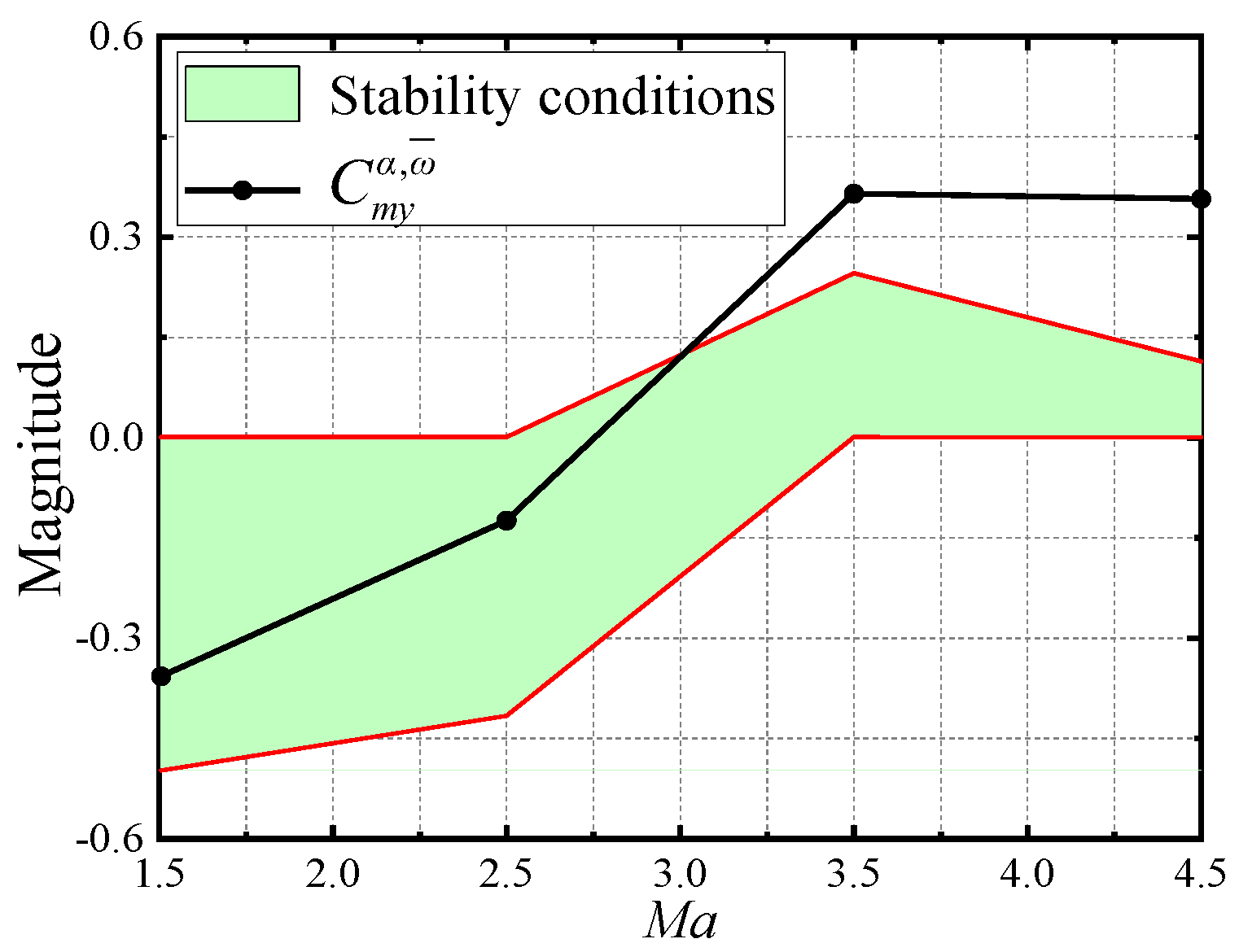1. Introduction
Long-range rockets typically have two stabilization methods. One is to provide gyroscopic stability through spin, and the other is to generate stabilizing moments using tail fins. For tube-launched rockets to be implemented, the tail fins must be folded, and among all folding schemes, the wrap-around fins (WAFs) that allow circumferential folding are the most optimal solution. To meet the speed and range demands of rockets, mitigate mass imbalance, thrust misalignment, and aerodynamic asymmetry, as well as streamline the control system, wrap-around-fin rockets commonly utilize rotational flight.
Wrap-around-fin rotating rockets generate force and moment perpendicular to the attack angle plane, referred to as out-of-plane force/moment in this context. Its generation is mainly caused by two factors. Firstly, the Magnus effect induced by the coupling of the angle of attack and rotational motion causes asymmetric distortions in the flow on both sides of the attack angle plane, resulting in out-of-plane forces and moments known as Magnus force/moment [
1]; secondly, the asymmetry in the shape of the wrap-around fin induces special characteristics of side force and yawing moment [
2]. Although the out-of-plane force is usually only 1~10% of the normal force, the out-of-plane moment has a significant impact on the dynamic stability of the rocket. The divergent conical motion induced by it can lead to flight failure. For example, the 140 mm wrap-around-fin rocket from Spain started to exhibit diverging conical motion 1.5 s after engine operation ceased, causing a 60% reduction in flight speed over the next 1.5 s, resulting in 9 catastrophic flights out of 28 experiments [
3]. Diverging conical motion has also been observed during the development of controlled and uncontrolled rockets in China [
4,
5], as illustrated in
Figure 1; therefore, the study of conical motion stability in rotating rockets is an important research field. Accurately predicting the aerodynamic characteristics of rotating rockets and gaining a deep understanding of the mechanisms generating out-of-plane force/moment will be an important foundation for stability analysis.
Researchers have conducted extensive studies on the longitudinal aerodynamic characteristics, self-induced rolling moment, and rolling moment reversal issues associated with wrap-around-fin rockets. Research shows that flat-plat-fin (FPF) and wrap-around-fin rockets with the same projected area and shape exhibit the same static stability coefficient, pressure center coefficient, and pitch damping at small angles of attack [
6]. Stevens conducted experiments to compare the aerodynamic characteristics of flat-fin and wrap-around-fin rockets, revealing the issue of multiple reversals of the rolling moment for the wrap-around-fin rocket at supersonic speeds [
2]. Subsequently, many researchers studied the effects of geometric parameters, such as the curvature radius, leading edge, and trailing edge shapes of wrap-around fins, on the rolling moment through experiments and steady-state numerical calculations. The results indicate that the strong shock waves on the concave surface of wrap-around fins, vortex systems at the connection of the convex surface and body, and the mutual interference of adjacent fin shock waves are the main reasons for the generation and reversal of the self-induced rolling moment [
7,
8,
9,
10,
11,
12]. Different wave and vortex systems near the flat fins and wrap-around fins directly affect the distribution of surface pressure, leading to significant differences in out-of-plane force/moment characteristics between the two. Additionally, the reversal of the rolling moment may change the rotation direction of the rocket, influencing the rotation-induced Magnus forces and moments, which could play a critical role in the dynamic stability of the rocket under critical conditions.
When in rotation, the out-of-plane force and moment of a wrap-around-fin rocket consist of a static component (static side force and yawing moment) and a Magnus component (Magnus force and moment). The former is only associated with the roll angle and is independent of the rotation rate, while the latter is induced solely by the rotation rate. Examining pressure distribution during the reversal of the rolling moment shows that the wrap-around-fin configuration displays a significant non-axisymmetric trait, where the static out-of-plane force and moment are relatively more pronounced than the Magnus force and moment at low rotation rate. G. Abate studied the impact of base cavities on the aerodynamic characteristics of rotating wrap-around-fin rockets through flight experiments, finding that there is a solution for eliminating dynamic instability regions by optimizing the rotation rate, geometric configurations of the fin and body, and geometric configurations of the cavity [
13]. J. Morote and G. Liano conducted numerical calculations on the steady aerodynamic characteristics of a 140 mm wrap-around-fin rocket using the inviscid Euler equations, investigating the effects of changes in fin span and chord length on the aerodynamic characteristics. They successfully reduced the out-of-plane moment characteristics of the rocket through modifications [
3]. Guoqing Zhang obtained the aerodynamic characteristics of wrap-around-fin rockets by solving the steady N-S equations, focusing on the effects of factors such as fin aspect ratio, curvature radius, installation angle, and number of fins on the out-of-plane force and moment characteristics. The results indicate that reducing the fin aspect ratio or increasing the curvature radius leads to reduced out-of-plane force characteristics [
14]. These two studies have limited investigation into the mechanism of induced out-of-plane force and moment caused by non-axisymmetric shapes and have overlooked the impact of rotational motion. In earlier work, Omer and Gokmen utilized ballistic experimental data to investigate the impact of the Magnus effect on the flight stability of wrap-around-fin missiles under transonic and low supersonic conditions. The results indicate that considering only the static out-of-plane moment characteristics of the wrap-around fin may lead to erroneous outcomes, highlighting the necessity to simultaneously consider the static out-of-plane force/moment, Magnus force/moment for an accurate analysis of missile flight stability [
15].
Therefore, this study conducted numerical simulations of the flow field around wrap-around-fin rockets under supersonic conditions with steady and unsteady rotation by solving the unsteady Reynolds-averaged Navier–Stokes equations, revealing the flow mechanisms inducing out-of-plane force/moment. This includes the structures of shock waves/expansion waves induced by the fins and their interference effects on the missile body. The study also compared and analyzed the contributions of the Magnus force/moment induced by rotational motion and the side force/yawing moment generated by non-axisymmetric shapes to the overall out-of-plane force/moment characteristics of the rocket. The variations in aerodynamic characteristics with angle of attack and Mach number were also calculated. The rocket’s angular motion process was analyzed by combining the angular motion equations. The conditions that the aerodynamic moment coefficients must meet for dynamic stability were derived. Subsequently, through shape optimization, such as altering the curvature radius of the fins, fin aspect ratio, and body aspect ratio, the out-of-plane force/moment of the wrap-around-fin rocket was reduced, effectively resolving issues associated with near misses and off-target impacts resulting from dynamic instability at high Mach numbers. In conclusion, this study explains the potential and reasons for the divergence of angular motion in wrap-around-fin rockets from an aerodynamic perspective, offering strong references and guidance for the design of related rotating rockets.
5. Conclusions
This study analyzed the aerodynamic characteristics and flow field structure of a large fineness ratio rotating wrap-around-fin rocket by solving the URANS equations. The side force and moment coefficients obtained from numerical calculations and experiments were compared to validate the reliability of the numerical method. The study derived the conditions necessary for the yawing moment coefficient to ensure stability during angular motion by incorporating the equations of angular motion. By varying the tail fin shape, tail fin aspect ratio, and body fineness ratio, the study investigated the effects of geometry and Mach number on the stability of the rotating wrap-around-fin rocket’s angular motion. The following conclusions were drawn:
- (1)
The differences in time-averaged out-of-plane force and moment between the wrap-around-fin and flat-fin rockets primarily stem from the tail fin and aftbody. The static out-of-plane force and moment generated by the non-planar symmetry of the wrap-around-fin configuration dominate the overall out-of-plane force and moment, which may play a decisive role in flight stability under critical conditions.
- (2)
The concave flow passage of the wrap-around fin contracts, maintaining high pressure due to the convergence of the shock wave, while the convex flow passage expands, causing airflow acceleration and pressure reduction, resulting in a strong asymmetry in pressure distribution on both sides of the wing that also disturbs the body, leading to significant side force and yawing moment characteristics.
- (3)
As the aspect ratio of the tail fin decreases, the out-of-plane force and moment of the tail fin and aftbody significantly decrease, leading to a reduction in the overall out-of-plane force and moment coefficients; the pitching moment coefficient decreases slowly with the decrease in tail fin aspect ratio, resulting in a decrease in the ratio of unstable moment to stable moment, making the rocket more likely to maintain stable flight.
- (4)
As the fineness ratio of the body decreases, the out-of-plane force and moment coefficients of the forebody significantly decrease, leading to a reduction in the overall out-of-plane force and moment coefficients; the pitching moment coefficient is minimally affected by the body fineness ratio, thus the ratio of unstable moment to stable moment decreases, making the rocket more likely to maintain stable flight.
- (5)
The angular motion stability boundaries of wrap-around-fin rockets and flat-fin rockets are very close, but the yawing moment coefficient of wrap-around-fin rockets is larger, more likely to exceed the angular motion stability boundaries, and thus more likely to cause flight instability. The stability region and the derivative of the yawing moment coefficient may change signs as the Mach number increases; thus, a special critical stability state may exist. An increase in Mach number reduces the range of the stability region, making it more difficult for the rocket to maintain stable flight.
This study had some limitations. First, the angular motion stability of wrap-around-fin rotating rockets was only analyzed at small angles of attack, with angular motion stability at large angles of attack not analyzed. Second, complex elastic deformations may cause significant changes in lateral aerodynamic characteristics when the wrap-around-fin rocket has a large fineness ratio, thereby affecting flight stability. This factor was not considered here. Significant progress has been achieved in our research in these two aspects, and we will discuss them in subsequent studies.
